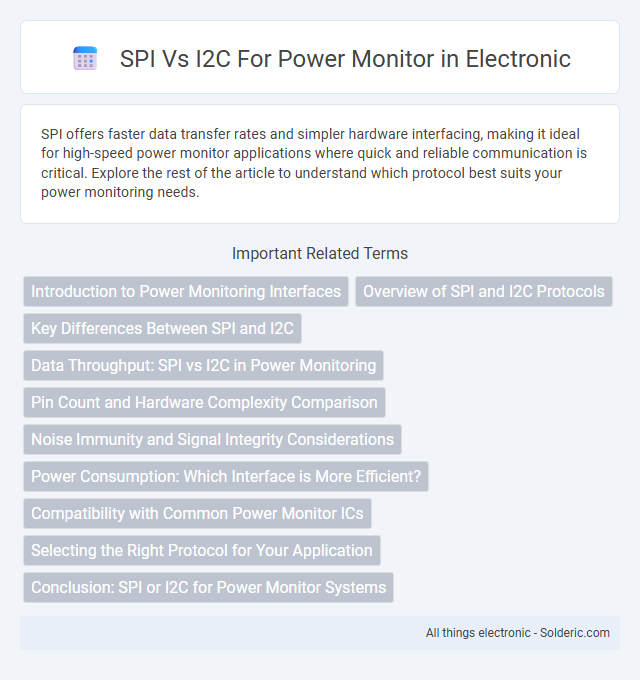SPI offers faster data transfer rates and simpler hardware interfacing, making it ideal for high-speed power monitor applications where quick and reliable communication is critical. Explore the rest of the article to understand which protocol best suits your power monitoring needs.
Comparison Table
| Feature | SPI | I2C |
|---|---|---|
| Communication Type | Serial Peripheral Interface (Synchronous) | Inter-Integrated Circuit (Synchronous) |
| Speed | Up to 50 Mbps (depending on hardware) | Up to 3.4 Mbps (High-speed mode) |
| Wiring | 4 wires (MOSI, MISO, SCLK, SS) | 2 wires (SDA, SCL) |
| Complexity | Moderate (requires separate chip select lines) | Low (address-based slave selection) |
| Power Efficiency | Higher power consumption due to increased signaling | Lower power consumption due to simpler wiring |
| Multi-slave Support | Limited (requires separate chip select for each slave) | Supports multiple slaves via address encoding |
| Error Checking | None inherently; external protocols needed | Built-in ACK/NACK for error detection |
| Use Case in Power Monitors | Fast, real-time data transfer with low latency | Simple integration with multiple sensors, slower refresh rate |
Introduction to Power Monitoring Interfaces
SPI and I2C are two prevalent interfaces used in power monitoring systems to facilitate communication between sensors and microcontrollers. SPI offers higher data transfer speeds and full-duplex communication, making it suitable for applications requiring rapid and precise power data acquisition. I2C, with its simpler wiring and multi-device addressing capability, provides an efficient solution for monitoring multiple power channels in a compact system, ensuring Your power monitoring setup remains both flexible and reliable.
Overview of SPI and I2C Protocols
SPI and I2C are common communication protocols used for interfacing power monitors with microcontrollers. SPI, or Serial Peripheral Interface, provides high-speed, full-duplex data transfer with separate lines for clock, data in, data out, and chip select, making it ideal for applications requiring quick and reliable data exchange. I2C, or Inter-Integrated Circuit, uses a two-wire interface with a shared clock and data line, supporting multiple devices with unique addresses and requiring fewer connections, which simplifies wiring in your power monitoring setup.
Key Differences Between SPI and I2C
SPI uses a full-duplex communication protocol with separate lines for data in, data out, clock, and chip select, enabling faster data transfer rates ideal for high-speed power monitoring applications. I2C operates on a two-wire serial bus with a single data line and clock line, supporting multiple devices with unique addresses but generally slower speeds compared to SPI. SPI's simplicity and speed contrast with I2C's multi-device capability and lower wiring complexity, influencing the choice depending on the power monitor's speed requirements and system design constraints.
Data Throughput: SPI vs I2C in Power Monitoring
SPI offers significantly higher data throughput than I2C, making it ideal for power monitoring applications requiring fast and continuous data transfer. SPI's full-duplex communication supports speeds up to several Mbps, whereas I2C typically maxes out around 400 kbps to 1 Mbps in fast mode. Your choice between SPI and I2C should consider the trade-off between speed and bus complexity for efficient power monitoring data acquisition.
Pin Count and Hardware Complexity Comparison
SPI interfaces typically require more pins than I2C, using at least four lines: MOSI, MISO, SCLK, and CS for each device, increasing hardware complexity in power monitor designs. I2C operates with only two lines, SDA and SCL, enabling simpler wiring and reducing PCB space in power monitoring applications. The lower pin count of I2C allows easier integration with microcontrollers but may trade off speed and dedicated device selection compared to SPI.
Noise Immunity and Signal Integrity Considerations
SPI offers superior noise immunity and signal integrity for power monitors due to its full-duplex communication and separate clock line, minimizing data errors in electrically noisy environments. I2C's open-drain bus and shared clock/data lines make it more susceptible to signal degradation and cross-talk, potentially impacting measurement accuracy. When designing your power monitoring system, prioritizing SPI can ensure reliable data transmission in industrial or high-interference scenarios.
Power Consumption: Which Interface is More Efficient?
SPI generally consumes more power than I2C due to its continuous clock signal and multiple data lines, which increase current draw during operation. I2C leverages a two-wire interface with bidirectional data and clock lines that operate at lower frequencies, typically reducing overall power consumption in battery-powered or energy-sensitive power monitoring applications. Your choice should consider the balance between speed and efficiency, with I2C often preferred for low-power scenarios.
Compatibility with Common Power Monitor ICs
SPI and I2C are commonly supported by power monitor ICs, but SPI often provides faster data rates and better noise immunity, making it suitable for high-precision measurements. Many popular power monitor ICs such as the Texas Instruments INA219 support I2C for simplicity and multi-device communication, while others like the Analog Devices ADE7953 favor SPI for enhanced speed and reliability. Compatibility with microcontrollers and system requirements ultimately guides the choice between SPI and I2C interfaces in power monitoring applications.
Selecting the Right Protocol for Your Application
Choosing between SPI and I2C for power monitoring hinges on factors like data speed, complexity, and wiring. SPI offers higher data rates and simpler point-to-point connections, making it ideal for applications requiring real-time, high-precision power measurements. Your decision should consider the trade-off between SPI's speed and I2C's simpler multi-device communication and fewer pin requirements.
Conclusion: SPI or I2C for Power Monitor Systems
SPI offers higher data transfer rates and better noise immunity, making it ideal for power monitor systems requiring precise, real-time measurements. I2C simplifies wiring with its two-wire interface, supporting multiple devices but at slower speeds and potential bus contention. Choosing SPI ensures faster, more reliable communication in power monitoring applications, while I2C suits simpler, lower-speed setups.
SPI vs I2C for Power Monitor Infographic

 solderic.com
solderic.com